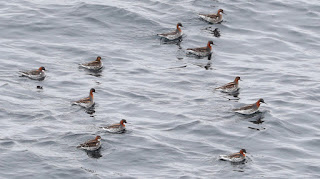The Codroy Valley at the southwest corner of Newfoundland is our Point Pelee, our High Island our .... well it is not really like any of those places except that nothing beats it in Newfoundland for lush birding and numerous specialties that are common just across the way in Nova Scotia but have gained a toe hold in Newfoundland here. It is a different world for the Avalon Peninsula birders that are used to looking eye level at tree top warblers. The Codroy Valley has proper forest and it is saturated with breeding birds.
This year where everyone's spring vacations to a birding destination were cancelled due to C-19, the obvious consolation vacation was the Codroy Valley. A full 900 km drive one way from St. John's, the travel time makes it a journey.
The majority of birders were present sometime in the period of late May to 12 June. Being tied up with a car problem my departure was well delayed. Alison Mews also with a car situation was delayed. The pain of hearing about the good birding that our friends were having caused Alison's car to be freed up and on short notice we were both streaming down the TCH toward Codroy Valley.
We had four full days 13-16 June. The weather was pretty good every day. Most importantly the winds were near calm each morning making for good dawn choruses. It turned out to be one of the best four day trips ever by anyone over the last 20+ years. We got all the regular Codroy specialties such as 5 Blackburnian Warblers, 9 Bay-breasted Warblers, 3 Cape May Warblers, 8 Northern Parulas, 18 Blue-headed Vireos,1 Philadelphia Vireo, 9 Red-eyed Vireos, 2 Eastern Wood Pewees, 4 Eastern Kingbirds, 2 Sora and 2 Pied-billed Grebes.
Rarities are actually rarely found on Codroy trips but we had three. The first was the best. A NORTHERN ROUGH-WINGED SWALLOW at Loch Lomond on 13 June. This near mythical bird has been reported nearly a handful of times in the province. This includes an individual accidentally caught in a mist net set up for snipe by the Great Legend himself - Dr. Les Tuck sometime in the 1960s and during June in the Codroy Valley. I held the study skin in my hand. It gave me faith that the species could really occur in NF. It did happen and we photos to prove it.
A singing Scarlet Tanager on Brooms Brook would have been a bigger surprise if an earlier Codroy team hadn't already had one. Ours was quite far away from the first sighting so was likely a different bird. Still a major rarity to hear the species singing in Newfoundland. We get a few in the autumn. No photos. Good sounds recordings.
The biggest surprise of the trip was a singing YELLOW-THROATED VIREO at Red Rocks Road on 15 June. Occurring once every two or three years during fall vagrant hunting season there were no spring records for the province. Alison and I spent two hours with the bird. I never saw it. Alison glimpsed it and got a just barely acceptable record shot. It was well sound recorded. Tried just about everything legal to see the bird. I walked across the brook to get into the thick woods where it was. I was under it singing. In desperation I pished quietly and the bird came down to me calling with its irritated call. It was clearly angry with me. So close I should have been able to touch it. But I could not see it. The record is documented with recordings of the song and one record shot photo. Sure would have been nice to have seen that bird.
The Northern Rough-winged Swallow at Loch Lomond, Codroy Valley, Newfoundland on 13 June 2020.
The Yellow-throated Vireo 15 June 2020, Red Rocks Road. The only photo. Taken by Alison Mews. There are good sound recordings.
The male and female Blackburnian warbler - one those Nova Scotia specialties.
The male and female Bay-breasted Warbler - another of those Nova Scotia specialties.
Philadelphia Vireo. Always a crowd-pleaser when you can see it.
The only Northern Parula of eight seen that I managed to get a photo of was this female.
For an Avalon birder where Hermit Thrush is the main thrush, it was a pleasure to endure the abundance of Swainson's Thrush in the Codroy Valley both by sight and by sound.
Eastern wood-Pewee is a regular spring overshoot from Nova Scotia without any suggestion of nesting in Newfoundland.
Bobolink used to be far more regular in Newfoundland. Now there are only a few in spring in the Codroy Valley. We don't know if they are still actually nesting anywhere in the province.
The scenic lush Codroy Valley is a Newfoundland birders heaven in late spring.
.



























